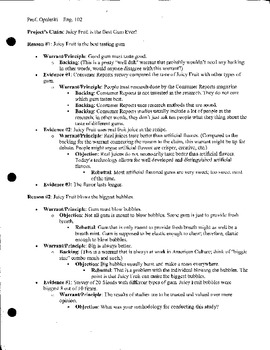
Toulmin Model of Argument: The twentieth-century British philosopher Stephen Toulmin noticed that good, realistic arguments typically will consist of six parts. He used these terms to describe the items. Data: The facts or evidence used to prove the argument Claim: The statement being argued (a thesis)File Size: KB Suggested/Possible Toulmin Essay Outline: I. Introduction a. Hook audience b. Deliver firm/explicit claim II. Definition/Historical Context III. Grounds 1 a. Evidence/Reason b. Warrant c. Backing IV. Grounds 2 a. Evidence/Reason b. Warrant c. Backing V. Grounds 3 a. Evidence/Reason b. Warrant c. Backing VI. Rebuttal a. Concession b. Refutation VII. Conclusion · Created by the British philosopher Stephen Toulmin, it involves the grounds (data), claim, and warrant of an argument. The Toulmin method suggests that these three parts are all necessary to support a good argument. The grounds are the evidence used to prove a claim. Why is the Toulmin model important?
How To Organize a Paper: The Toulmin Method – The Visual Communication Guy
While this method is intended for giving complex and well-supported arguments that are mindful of what opponents will say in response to your claims, the Toulmin Method is a one-sided argument that does not attempt to build common ground, as the Rogerian Method toulmin method outline. The goal of the Toulmin Method is to persuade the reader that your argument is reasonable and effective based on thorough research and organization. You will find the Toulmin Method most useful to write theoretical essays or academic papers.
The Toulmin Method is effective in presenting thorough support for your argument. Thus, it is ideal for arguments in which there will be much dissent or controversy surrounding the argument.
It is also useful for making complex arguments. When you write using the Toulmin Method, you need to be prepared to know and explain every facet of your argument. The goal is to be as detailed and persuasive about your argument as possible, countering opposing views etc, toulmin method outline.
The Toulmin Method may not convince an opposing party that you are right, but it shows that you have solid evidence and reasoning behind your argument, regardless of what they may think of the argument itself. The steps only show one possible way of organizing the Toulmin Method, toulmin method outline. The image shows that there may be a need to go back and re-visit different steps in order to fully support all areas of the argument. Imagine that you want to present an argument stating toulmin method outline smoking tobacco should be banned toulmin method outline all college campuses.
This would be your claim. The grounds on which you would base this claim would possibly note the health risks associated with secondhand smoke. The warrant may present the idea that the health risks of secondhand smoke hinder learning, which may be warranted by a study that shows the effects of secondhand smoke on learning.
A rebuttal to the argument could be that smoking tobacco is a way that some students relax in between classes or that it is only harmful if extremely high levels of secondary smoke are ingested. Toulmin, Stephen, et al. An Introduction to Reasoning. Macmillan Publishing Co.
Share 1. Pin 1.
Writing Essays and Using the Toulmin Method
, time: 7:05Toulmin Method Outline: Toulmin Model Essay Outline - iWriteEssays

Developed by philosopher Stephen E. Toulmin, the Toulmin method is a style of argumentation that breaks arguments down into six component parts: claim, grounds, warrant, qualifier, rebuttal, and backing. In Toulmin’s method, every argument begins with three fundamental parts: the claim, the grounds, and the warrant Toulmin Model of Argument: The twentieth-century British philosopher Stephen Toulmin noticed that good, realistic arguments typically will consist of six parts. He used these terms to describe the items. Data: The facts or evidence used to prove the argument Claim: The statement being argued (a thesis)File Size: KB Stephen Toulmin, an English philosopher, developed a practical approach to analyzing the logic of everyday arguments. His approach involves identifying and separating the various components of an argument into a specific order so that they may be appraised. The model and specific vocabulary that Toulmin employs will be elaborated as required

No comments:
Post a Comment